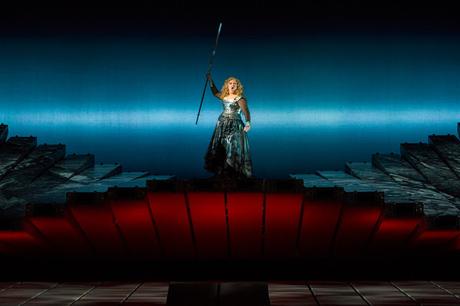by Paul J. Pelkonen

Fearless: Christine Goerke makes her Act II entrance as Brunnhilde in Die Walküre.
Photo by Richard Termine © 2019 The Metropolitan Opera.
Inside the opera house, anticipation was high for the arrival of Christine Goerke in the role of Brunnhilde. The Long Island-born soprano went through a remarkable career rebirth in the last decade, turning to the heaviest roles in the (mostly German) repertory. Brunnhilde, whose adventures span across three Ring operas is a watershed part. From her entrance atop the Machine, Ms. Goerke proved a well-acted bundle of energy, and maybe the first soprano to look at ease singing on the high-flying set. She walked Brunnhilde's dramatic arc too, in a vulnerable performance that tracked her development from being a minion of her father Wotan to a mature woman who (thanks to some very human moral choices) falls victim to her father's wrath.
From her first series of "Hojotohos", Ms. Goerke sang with fire and guts. She added the trills to her battle cries, thrilling the audience, and then won them over with her bright stage presence and inrtense energy. She shared a real emotional bond with Greer Grimsley's Wotan, acting not just as his foil but showing through gesture, look and glance all of the depths of the character even when not singing. This approach carried to her spectral entrance before the doomed warrior Siegmund, and the deep, otherworldly tone she summoned for the following Annunciation of Death.
Mr. Grimsley was less than endearing in Das Rheingold (the first segment of the Ring) but his Walküre Wotan was something else. The singer got better and the five hour opera rolled in, capturing the sense of inner torment in the long Act II monolog and dispatching Hunding (Gunther Groissböck) with a single venomous glance. (This sudden end might count as the worst death in opera.) He was even better in the third act, all bluster in front of his nine Valkyrie daughters, and slowly melting to warmth once he was alone with Brunnhilde. The Farewell was sung with heart eating tenderness, accompanied on an ocean wave of sound by the always superb Met orchestra under the brisk leadership of Philippe Jordan.
The incestuous affair between the twins Siegmund and Sieglinde (and the latter's escape from a loveless, abusive marriage to her husband Hunding) is the plot motor of this opera. Stuart Skelton and Eva-Marie Westbroek have sung these role before in this production, and their experience paid handsome dividends here. Mr. Skelton sang with firm tone, although his big, belted notes almost vanished at the end of the first act. He recovered, summoning baritone depths for his big scene with Brunnhilde. Ms. Westbroek developed from cowed hausfrau to full soprano power, breaking out of Sieglinde's shell to deliver a powerhouse performance. Her exit, where the now-pregnant Sieglinde sings the "redemption theme" (that will prove crucial in the last part of the cycle) was especially affecting.
It is Wotan's wife Fricka that drops the (metaphorical) hammer on the twins, insisting that Wotan protect Hunding in the coming fight. In this role, Jamie Barton was (almost) stuck on the one balky item in the show, a rolling rams-head throne that is supposed to enable her grand entrance but looked wobbly. However, there were no problems with her singing: she sang these stern lines with power and ease. She ran rings around Wotan with the ease of a practiced courtroom lawyer, maneuvering him into the trap that his own actions had built. As Hunding, Mr. Groissböck played this nasty figure with an authoritative bass that has made him a Met mainstay in recent seasons.
Philippe Jordan’s light-footed approach to conducting Walküre kept the action moving without sacrificing any of the big moments. The Ride of the Valkyries remains the best visual moment in this entire cycle, and the eight singers slid safely off their mechanical mount to audience applause. The Met players responded to his approach with apparent enthusiasm, creating clear textures that showed Wagner's orchestration in the best possible light. Most importantly, this whole performance had the sense of relentless forward momentum. In a five hours-plus opera that can be (fairly) accused of having longeurs, there were none. It's a pity then, that this is the only Ring performance being filmed for broadcast this season: this Die Walküre is one for the books.
If you enjoyed this article, it's time to click over to Superconductor's Patreon page, and help support the cost of independent music journalism in New York City at the low cost of just $5/month.

